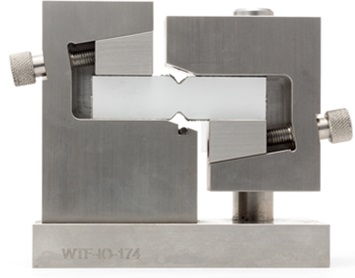Most test plans for material characterization use standard uniaxial tension or compression methods. The test data can then be used to select and calibrate a material model for finite element (FE) simulation. Typical engineering materials and structures experience more complex deformation and stress states, and it is important to capture fully a material’s response. Shear testing is one way to characterize a material’s response or to validate a material model after calibration.
The v-notch shear test, shown in the image here, is designed to characterize a material’s response under shear loading and is based on ASTM D5379. A rectangular specimen with opposing ‘v’ shaped notches is placed in the test fixture. One side of the specimen is constrained while the other side is pressed down. Deformation is concentrated along a thin line connecting the opposing v notches, thereby producing a shear stress and deformation state. Applied load and displacement are measured until specimen failure. Digital Image Correlation can also be used to obtain the surface strains of the specimen. The results from this test are typically used to characterize the shear stress-shear strain response of a material and to validate a material model developed solely with data from other testing models.
For a customized quotation, please write to us at testing@veryst.com.
